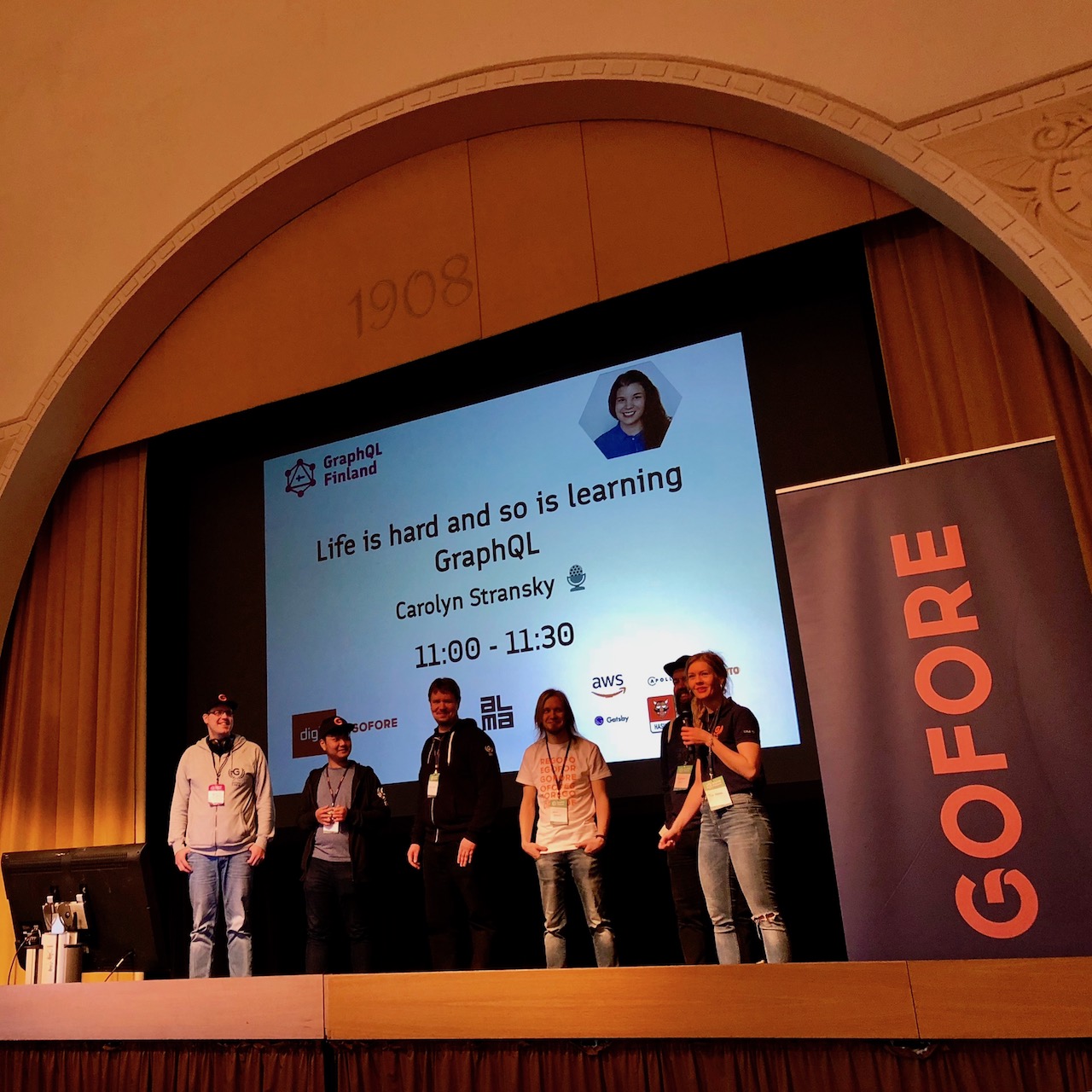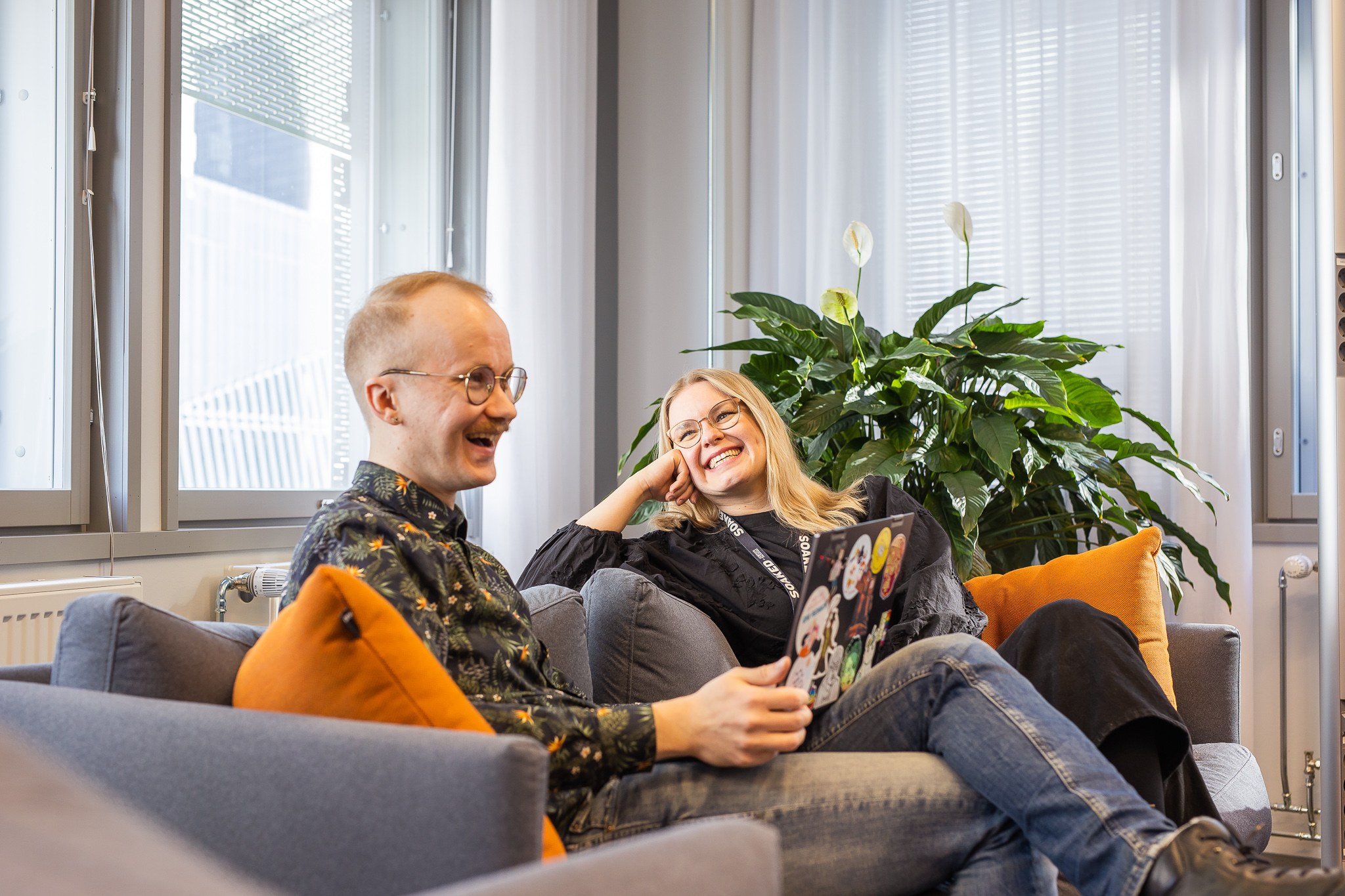The GraphQL Finland 2018 conference was held recently (18-19.10.2018) at Paasitorni and was the first event of its kind in Finland. The conference brought a day of workshops and a day of talks around GraphQL. It was organized by the same people as React Finland as the good organisation showed. The talks were interesting, the venue was appropriate, food delicious, the atmosphere was cosy and the after party was awesome. Gofore was one of the gold sponsors and organized the afterparty at Kamppi.
All of the talks were live streamed and they are available on Youtube. I was lucky to get a ticket to the event and be able to enjoy the talks live. Overall, most of the talks were easy to comprehend although I only had a little experience with GraphQL through experiments and what I had learnt a couple of months ago at the React Finland 2018 conference.
“GraphQL is an open source data query and manipulation language, and a runtime for fulfilling queries with existing data. It was developed internally by Facebook in 2012 before being publicly released in 2015. It provides a more efficient, powerful and flexible alternative to REST and ad-hoc web service architectures. It allows clients to define the structure of the data required, and exactly the same structure of the data is returned from the server, therefore preventing excessively large amounts of data from being returned. – Wikipedia“
You can also read the organizer’s summary of the event and check out the photos.
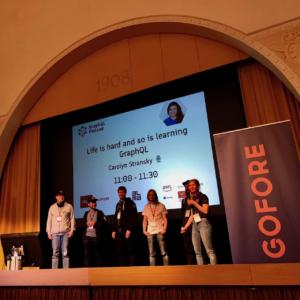
(Life is hard, learning GraphQL easy)
Notes from the conference
The talks at GraphQL Finland were quite fast paced and more like lightning talks compared to the React Finland event: it was quite tough to digest all the new information. Fortunately, the talks were recorded so you can concentrate on interesting and relevant topics and get back to others later. Also, the sponsor’s lounge by Gofore and Digia provided a nice relaxing space to get your thoughts together. I have to say, Digia’s Star Wars Pinball machine was quite fun ![]()
The talks covered different aspects of GraphQL and surrounding topics in details. Here’s my notes from the talks which I found most interesting and watched live at the event.
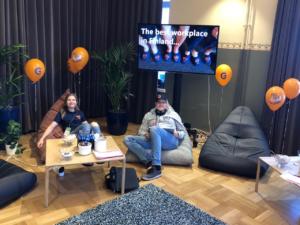
(Goforeans in the sponsor lounge)

(Goforeans challenging attendees to foosball)
Adopting GraphQL in Large Codebases – Adam Miskiewicz
The event started with Adam Miskiewicz’s story from Airbnb and incrementally adopting GraphQL. It’s simple to start using GraphQL in your project but adding it incrementally and carefully in huge codebases powering large distributed systems is not quite as straightforward. The talk dived into how Airbnb is tackling this challenge, what they’ve learned so far, and how they plan to continue evolving their GraphQL infrastructure in the future. Towards GraphQL Native!
#GraphQLFinland started with @skevy talking about how @AirbnbEng incrementally adopted #GraphQL in large codebase. Why, when, how, where? Enables evolving API in new ways. Still iterating, towards GraphQL Native. pic.twitter.com/DiSKy4gmmY
— Marko Wallin (@walokra) October 19, 2018
Going offline first with GraphQL — Kadi Kraman
Kadi Kraman from Formidable Labs talked about going offline first with GraphQL. She did a nice interactive demo with React Native and Apollo 2. Users expect your mobile app to work offline and the tooling in GraphQL makes it reasonably straightforward to get your React Native app working offline. Slides
“Do this as you go and offline comes almost as a side-effect”
“Do this as you go and offline comes almost as a side-effect” – Going offline first with #GraphQL by @kadikraman at @GraphQLFinland. Nice interactive demo with #ReactNative and #Apollo2. Slides: https://t.co/T5neq5Zxln. #graphqlfinland pic.twitter.com/t5v5Bx2g9s
— Marko Wallin (@walokra) October 19, 2018
Life is hard and so is learning GraphQL — Carolyn Stransky
Life is hard, without documentation. Carolyn Stransky presented her story of ups and downs when learning GraphQL and documentation’s role in it. The problem with GraphQL is that – because there’s no “vanilla” GraphQL – there’s no central hub for all of the information and tooling necessary to learn it. It’s under-utilised and scattered throughout our community. The talk touched on how to better enable GraphQL docs for learning and comprehension and the slides pointed to good resources.
Documentation is one pain point of learning new things. @carolstran talked how we can better enable #GraphQL docs for learning and comprehension at @GraphQLFinland. Slides pointed to good resources: https://t.co/kZ9qGwS72Z. #graphqlfinland pic.twitter.com/uyCaDoec8h
— Marko Wallin (@walokra) October 19, 2018
Database-first GraphQL Development — Benjie Gillam
Benjie Gillam from PostGraphile taught how a database-centric approach to GraphQL API development can give your engineers more time to focus on the important parts of your application. Adhere to GraphQL best practices, embrace the power of PostgreSQL, and avoid common pitfalls. Interesting slides.
Databases and #GraphQL with PostGraphile 🤔 @Benjie talked about Database-first GraphQL development at @GraphQLFinland. Data-centric approach can give time to focus on important parts of your app. Interesting slides: https://t.co/LdITgG39kd. #graphqlfinland pic.twitter.com/KlS0CoTG34
— Marko Wallin (@walokra) October 19, 2018
graphql-php — Christoffer Niska
Christoffer Niska gave some good tips for software development: Don’t over-abstract, test everything, use static type checking, follow best practices, don’t prematurely optimise.
Listening good general tips for software development from @Crisu83 at @GraphQLFinland stream while lounging at @GoforeGroup sponsor lounge. Don’t over-abstract, test everything, use static type checking, follow best practices, don’t prematurely optimize. #graphqlfinland pic.twitter.com/jrc07Uo8xs
— Marko Wallin (@walokra) October 19, 2018
The (Un)expected use of GraphQL talk by Helen Zhukova showed the benefit of a single code base on the client and server side. Partly live coded with i.a. CodeSandbox. The any DB, in this case, was MongoDB.
(Un)expected use of #GraphQL talk by @return_hz at @GraphQLFinland showed the benefit of single code base on client and server side. Partly live coded with i.a. @codesandboxapp. The any DB in this case was MongoDB. #graphqlfinland pic.twitter.com/kRMILt2oxu
— Marko Wallin (@walokra) October 19, 2018
Mysterious closing keynote — Dan Schafer
The mysterious closing keynote was Dan Schafer talking about GraphQL history, present and future. “Strive for single sources of truth”. Still lots of things to do in the ecosystem.
Day full of #GraphQL information borbardment at @GraphQLFinland closed with a mysterious keynote by @dlschafer. The past, present and future of GraphQL. “Strive for single sources of truth”. Still lots of things to do in the ecosystem. #graphqlfinland pic.twitter.com/u9ypVRwOpl
— Marko Wallin (@walokra) October 19, 2018
Afterwords
The last chance to practice your Finnish was at the Afterparty ? at the Gofore office!
“Someone said your afterparty was the best conference party ever :)”
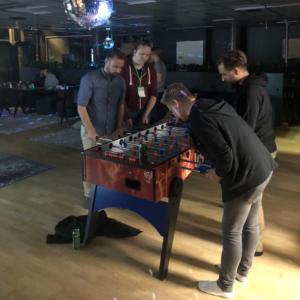
Foosball was popular also at the afterparty.
